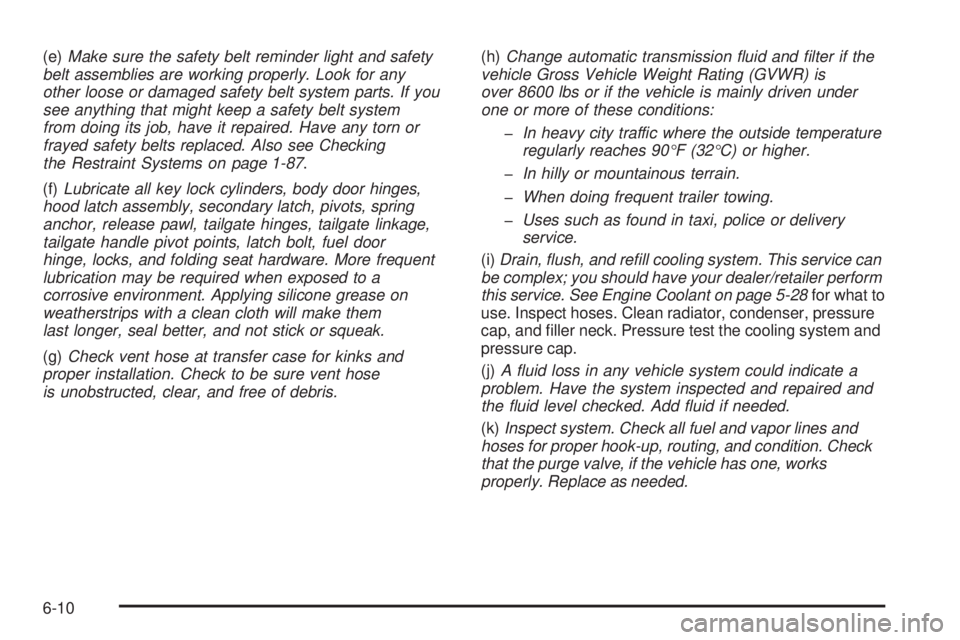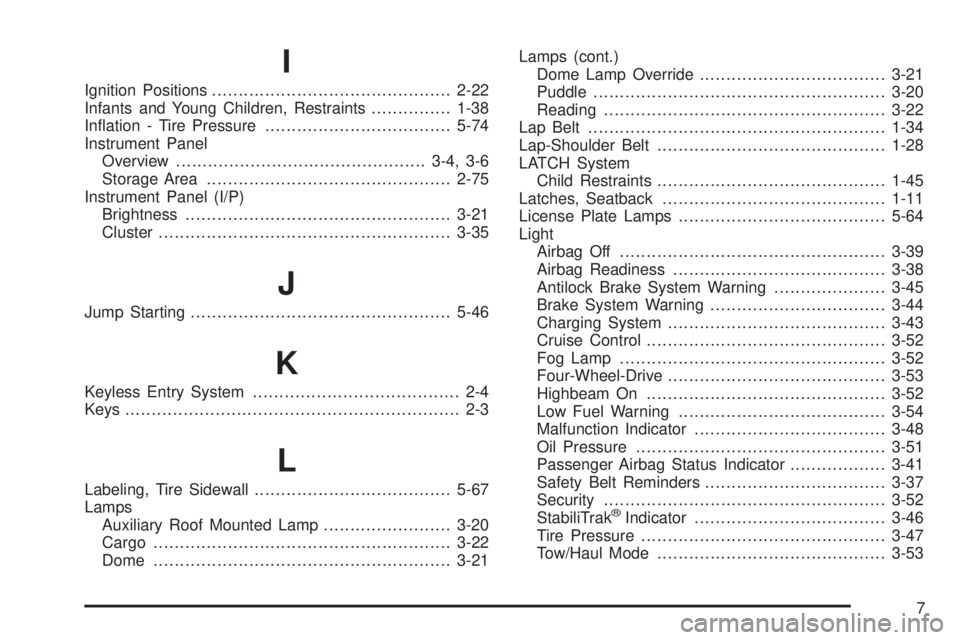2008 GMC SIERRA fuel pressure
[x] Cancel search: fuel pressurePage 468 of 578

Dual Tire Operation
When the vehicle is new, or whenever a wheel,
wheel bolt or wheel nut is replaced, check the wheel
nut torque after 100, 1,000 and 6,000 miles
(160, 1 600 and 10 000 km) of driving. For proper
torque and wheel nut tightening information, see
Removing the Spare Tire and Tools on page 5-93.
The outer tire on a dual wheel setup generally wears
faster than the inner tire. Your tires will wear more
evenly and last longer if you rotate the tires periodically,
seeTire Inspection and Rotation on page 5-81. Also see
Scheduled Maintenance (Gasoline Engine) on page 6-4.
{CAUTION:
If you operate your vehicle with a tire that is
badly underin�ated, the tire can overheat. An
overheated tire can lose air suddenly or catch
�re. You or others could be injured. Be sure all
tires (including the spare) are properly in�ated.
SeeInflation - Tire Pressure on page 5-74, for
information on proper tire in�ation.
Tire Pressure Monitor System
The Tire Pressure Monitor System (TPMS) uses radio
and sensor technology to check tire pressure levels. The
TPMS sensors monitor the air pressure in your vehicle’s
tires and transmit tire pressure readings to a receiver
located in the vehicle.
Each tire, including the spare (if provided), should be
checked monthly when cold and in�ated to the in�ation
pressure recommended by the vehicle manufacturer
on the vehicle placard or tire in�ation pressure label.
(If your vehicle has tires of a different size than the size
indicated on the vehicle placard or tire in�ation pressure
label, you should determine the proper tire in�ation
pressure for those tires.)
As an added safety feature, your vehicle has been
equipped with a tire pressure monitoring system (TPMS)
that illuminates a low tire pressure telltale when one or
more of your tires is signi�cantly under-in�ated.
Accordingly, when the low tire pressure telltale
illuminates, you should stop and check your tires as
soon as possible, and in�ate them to the proper
pressure. Driving on a signi�cantly under-in�ated tire
causes the tire to overheat and can lead to tire failure.
Under-in�ation also reduces fuel efficiency and tire
tread life, and may affect the vehicle’s handling and
stopping ability.
5-76
Page 534 of 578

(e)Make sure the safety belt reminder light and safety
belt assemblies are working properly. Look for any
other loose or damaged safety belt system parts. If you
see anything that might keep a safety belt system
from doing its job, have it repaired. Have any torn or
frayed safety belts replaced. Also see Checking
the Restraint Systems on page 1-87.
(f)Lubricate all key lock cylinders, body door hinges,
hood latch assembly, secondary latch, pivots, spring
anchor, release pawl, tailgate hinges, tailgate linkage,
tailgate handle pivot points, latch bolt, fuel door
hinge, locks, and folding seat hardware. More frequent
lubrication may be required when exposed to a
corrosive environment. Applying silicone grease on
weatherstrips with a clean cloth will make them
last longer, seal better, and not stick or squeak.
(g)Check vent hose at transfer case for kinks and
proper installation. Check to be sure vent hose
is unobstructed, clear, and free of debris.(h)Change automatic transmission fluid and filter if the
vehicle Gross Vehicle Weight Rating (GVWR) is
over 8600 lbs or if the vehicle is mainly driven under
one or more of these conditions:
�In heavy city traffic where the outside temperature
regularly reaches 90°F (32°C) or higher.
�In hilly or mountainous terrain.
�When doing frequent trailer towing.
�Uses such as found in taxi, police or delivery
service.
(i)Drain, flush, and refill cooling system. This service can
be complex; you should have your dealer/retailer perform
this service. See Engine Coolant on page 5-28for what to
use. Inspect hoses. Clean radiator, condenser, pressure
cap, and �ller neck. Pressure test the cooling system and
pressure cap.
(j)A fluid loss in any vehicle system could indicate a
problem. Have the system inspected and repaired and
the fluid level checked. Add fluid if needed.
(k)Inspect system. Check all fuel and vapor lines and
hoses for proper hook-up, routing, and condition. Check
that the purge valve, if the vehicle has one, works
properly. Replace as needed.
6-10
Page 535 of 578

(l)Extreme Duty Service: Change transfer case fluid if
the vehicle is mainly driven off-road in four-wheel
drive, or is used for heavy trailer towing. Farming,
mining, forestry, and Department of Natural Resources
(DNR) vehicles meet this definition.
(m)During any maintenance, if a power washer is used
to clean mud and dirt from the underbody, care should be
taken to not directly spray the transfer case output seals.
High pressure water can overcome the seals and
contaminate the transfer case fluid. Contaminated fluid
will decrease the life of the transfer case and should be
replaced.
(n)Vehicles with diesel engine or with GVWR above
10,000 lbs (4 536 kg) only: Inspect shields for damage or
looseness. Adjust or replace as required. This is a
Noise Emission Control Service. Applicable to vehicles
sold in the United States and recommended for
vehicles sold in Canada.
(p)If you drive regularly under dusty conditions, inspect
the filter or change indicator (if equipped) at each
engine oil change.
(q)Visually inspect belt for fraying, excessive cracks, or
obvious damage. Replace belt if necessary.Owner Checks and Services
These owner checks and services should be performed
at the intervals speci�ed to help ensure the safety,
dependability, and emission control performance of your
vehicle. Your dealer/retailer can assist you with these
checks and services.
Be sure any necessary repairs are completed at once.
Whenever any �uids or lubricants are added to your
vehicle, make sure they are the proper ones, as shown
inRecommended Fluids and Lubricants on page 6-15.
At the First 100, 1,000 and 6,000
Miles (160, 1 600 and 10 000 km)
For vehicles with dual wheels, check dual wheel
nut torque. For proper torque, seeCapacities and
Specifications on page 5-130.
At Each Fuel Fill
It is important to perform these underhood checks at
each fuel fill.
6-11
Page 570 of 578

Fuel (cont.)
Fuels in Foreign Countries.............................. 5-9
Gage.........................................................3-53
Gasoline Octane........................................... 5-6
Gasoline Speci�cations.................................. 5-6
Low Warning Light.......................................3-54
Fuses
Center Instrument Panel Fuse Block.............5-125
Fuses and Circuit Breakers.........................5-123
Instrument Panel Fuse Block.......................5-124
Underhood Fuse Block...............................5-126
Windshield Wiper.......................................5-123
G
Gage
Engine Coolant Temperature.........................3-46
Fuel..........................................................3-53
Oil Pressure...............................................3-50
Speedometer..............................................3-36
Tachometer.................................................3-36
Voltmeter Gage...........................................3-43
Garage Door Opener.......................................2-68
Gasoline
Octane........................................................ 5-6
Speci�cations............................................... 5-6
Glove Box.....................................................2-74
GM Mobility Reimbursement Program.................. 7-6
H
Hazard Warning Flashers................................... 3-8
Head Restraints..............................................1-10
Headlamp
Aiming.......................................................5-56
Headlamps....................................................5-60
Bulb Replacement.......................................5-59
Daytime Running Lamps...............................3-18
Exterior Lamps............................................3-17
Flash-to-Pass..............................................3-11
Halogen Bulbs............................................5-59
High/Low Beam Changer..............................3-11
On Reminder..............................................3-18
Pickup Box Identi�cation and Fender
Marker Lamps.........................................5-62
Heated Seats................................................... 1-6
Heater...................................................3-25, 3-27
Heater...........................................................3-28
Highbeam On Light.........................................3-52
Highway Hypnosis...........................................4-29
Hill and Mountain Roads..................................4-30
Hood
Checking Things Under................................5-12
Release.....................................................5-13
Horn............................................................... 3-8
How to Wear Safety Belts Properly...................1-19
6
Page 571 of 578

I
Ignition Positions.............................................2-22
Infants and Young Children, Restraints...............1-38
In�ation - Tire Pressure...................................5-74
Instrument Panel
Overview...............................................3-4, 3-6
Storage Area..............................................2-75
Instrument Panel (I/P)
Brightness..................................................3-21
Cluster.......................................................3-35
J
Jump Starting.................................................5-46
K
Keyless Entry System....................................... 2-4
Keys............................................................... 2-3
L
Labeling, Tire Sidewall.....................................5-67
Lamps
Auxiliary Roof Mounted Lamp........................3-20
Cargo........................................................3-22
Dome........................................................3-21Lamps (cont.)
Dome Lamp Override...................................3-21
Puddle.......................................................3-20
Reading.....................................................3-22
Lap Belt........................................................1-34
Lap-Shoulder Belt...........................................1-28
LATCH System
Child Restraints...........................................1-45
Latches, Seatback..........................................1-11
License Plate Lamps.......................................5-64
Light
Airbag Off..................................................3-39
Airbag Readiness........................................3-38
Antilock Brake System Warning.....................3-45
Brake System Warning.................................3-44
Charging System.........................................3-43
Cruise Control.............................................3-52
Fog Lamp..................................................3-52
Four-Wheel-Drive.........................................3-53
Highbeam On.............................................3-52
Low Fuel Warning.......................................3-54
Malfunction Indicator....................................3-48
Oil Pressure...............................................3-51
Passenger Airbag Status Indicator..................3-41
Safety Belt Reminders..................................3-37
Security.....................................................3-52
StabiliTrak
®Indicator....................................3-46
Tire Pressure..............................................3-47
Tow/Haul Mode...........................................3-53
7